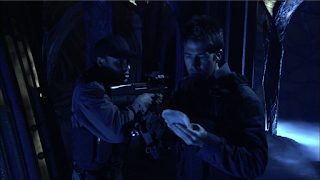As
the pilot of Stargate Atlantis, “Rising”
was the culmination of the buildup from the SG-1
episodes “Lost City” and “New Order”, themselves the culmination of numerous
plot threads surrounding the Ancients.
If this pilot had failed, then it—and all the SG-1 story arcs that preceded it—would have been all for
nothing. As such, it is so satisfying
that Stargate Atlantis managed to
find its own ground in its first episode.
Though
directly continuing from the story arcs of Stargate
SG-1, “Rising” does quite a good job at quickly filling in any new viewers
regarding the mythology basics SG-1
had established. In addition, “Rising”
provides a first look into a change of pace with said mythology. Aside from Atlantis itself, the Pegasus
Galaxy is not influenced by any of Earth’s real-life mythologies, unlike the
Milky Way in the original SG-1. This is made very clear in “Rising”, which is
devoted to raising early questions such as: What happened to the Ancients? Why did they leave Earth long ago? Who are the Wraith? Many of these questions are further explored
in later episodes of the series, which also branches out to explore other
mythological threads—just like SG-1.
The
pilot also has stunning high-budget visual effects to boast. The geometric set design of Atlantis’s
interior is suitable enough for the Tau’ri and is a true reflection of an
advanced ancient civilization built by the ancestors of the Tau’ri. By contrast, the Wraith Hive’s biomechanical
structure resembles a true alien hive.
There is a general unnerving atmosphere in the hive, and the dark
lighting only adds to it. The CGI looks
surprisingly realistic, even 15 years later, with some breathtaking visual
effects and action sequences throughout the episode.
The
city of Atlantis itself, while an alien ship at its core, is nonetheless based
in plausibility and practicality. In the
episode, there is a subplot revolving around the city’s systems failing. This makes sense because practically
speaking, there is no way that a megastructure—let alone a city-ship—of that
size could sustain itself for millions of years. The notion that the waterproof shield keeping
Atlantis at bay is about to collapse creates a looming suspense that makes
Major Sheppard and his team’s problems that they encounter more suspenseful
with every passing second.
Much
of the episodes’ plot is structured around suspense. Firstly, Atlantis’s dome shield, keeping the
water from crashing in on the city, is failing after millions of years; there
is the possibility that Atlantis could be flooded once that shield fails. Even after all these years, it still makes the
audience wonder if Dr. Weir, Rodney, & co. will find a resolution to this
situation. The resolution to this is a
failsafe that is built up so well right up to the last moment. On the surface, it may seem like a deus ex machina;
but in its defense, it works because it adds to the sense that there is much
more to Atlantis that the Tau’ri don’t know about. After all, it raises another mystery: how did
the Ancients prepare such a failsafe to happen? (Resolved in a later episode,
“Before I Sleep”)
The
introduction of the main villains of the series, the Wraith, is also very
suspenseful and executed extremely well.
First shrouded in mystery and mentioned in name only by the Athosians,
more hints about the Wraith progressively build up before their proper
introduction. The Athosians, especially
Teyla Emmagan, build the Wraith up as a serious threat that brings constant
terror to their people. As such, when
the Wraith are introduced, they deliver fully on how terrifying they really
are. To add to that, the prosthetic
costume for the Wraith treads the uncanny valley in a good way, depicting a
creature that looks somewhat human, but visually different enough to make it
alien. And that makes it all the more
horrifying.
Given
that Stargate SG-1 was already an
iconic cult sensation in its own right going strong for seven years in 2004, Stargate Atlantis played a crucial role
in expanding Stargate into the
lucrative media franchise it was during the 2000s. For all the setup that “Lost City” and “New
Order” provided, “Rising” was the key stepping stone in that process. From “Rising” onward, Atlantis stepped out of SG-1’s
shadow and succeeded as a remarkable sci-fi TV series in its own right.








No comments:
Post a Comment